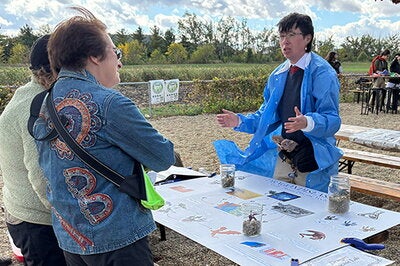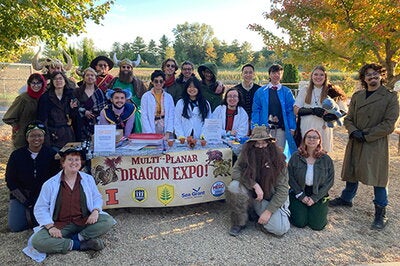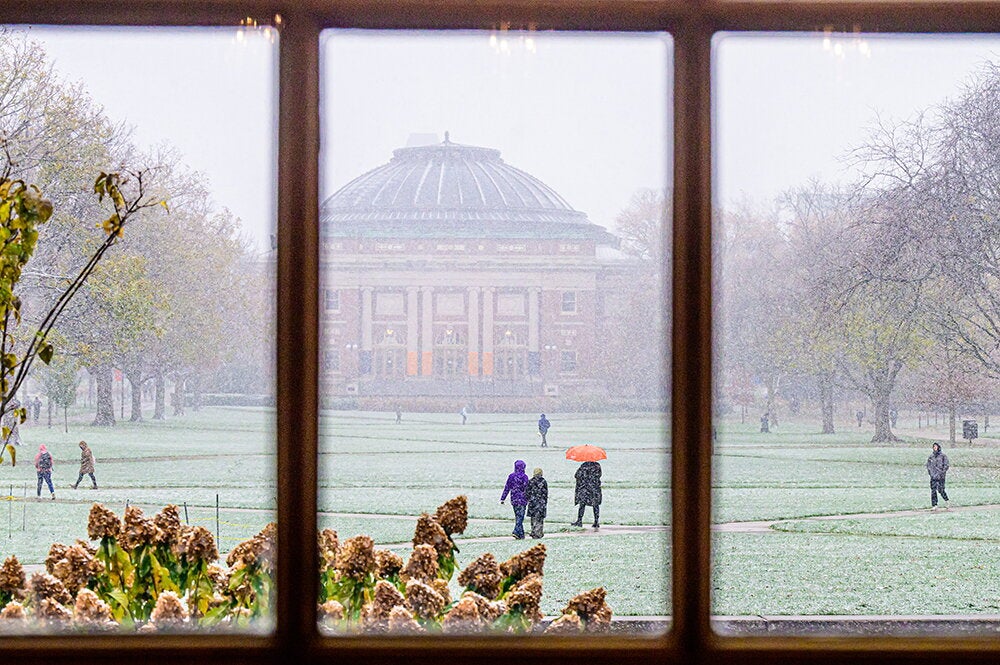

Disease swept across the planes, threatening the dragons of Faerûn. Blue lab coat blowing in the wind, Adrien Seabloom poured over a diagram of dragon species, locations, and possible sources of the disease. He and his trusty lab assistants, a pair of rats peeking out of a pouch, were looking for help from adventurers to test dragon blood samples and map out the disease vectors.
Fear not! There are no dragons, nor draconic diseases in Urbana-Champaign. Seabloom was part of the Multi-Planar Dragon Expo in October, where scientists tapped into fantastical worlds to make science approachable and accessible for everyone.
“The Multi-Planar Dragon Expo was essentially what they call a pop-up museum,” professor of evolution, ecology, and behavior Philip Anderson said. “It’s an event where we share with the public some scientific ideas, but we do it through a narrative of pop culture.”
The expo was put together by Anderson and volunteer panelists. It is one of several themed science-meets-fantasy events he has organized in collaboration with Cosplay For Science and the university.
Cosplay for Science is a science communication initiative using fandoms to “meet the public halfway” with something they are already interested in. Anderson met one of the founders of Cosplay for Science at a conference a few years ago, where another member did a presentation on tying Pokémon into entomology — the study of insects.

“I talked to them afterwards about the fact that I don’t know a lot about Pokémon, but I’m really into Dungeons and Dragons,” he said. “And if you read the ‘Monster Manual’ for Dungeons and Dragons, it’s really clear that somebody with a biology background is on that writing staff.
“They have all sorts of descriptions for these monsters that involve things like their life cycle, or their ecology. It really struck me that we should be able to do something with this and teach people a little bit about not just scientific facts, but even the scientific process, through this lens of thinking about these fun, fantastical creatures.”
Seabloom, a graduate student in the Program in Ecology, Evolution & Conservation Biology, played a studious ranger from Faerûn. He explained to expo attendees how stirges, which the D&D “Basic Rules” describe as “a cross between a large bat and an oversized mosquito,” drink dragon blood. This normally does little harm to the dragons of Faerûn.
“However,” Seabloom said, “our colleagues in other dimensions have seen stirges traveling between Faerûn and their world. If they feed on infected dragons from other worlds, the stirge can become a vector for a new pathogen that can make red dragons sick if the stirge comes back to our world and feeds on them.”
In order to find a cure, the correct pathogen must be identified. Seabloom walked attendees through a mock blood test to determine which pathogen the dragon is affected by.
“A lot of it is not just giving facts, but trying to show how scientists work through problems,” Anderson said.
There were a variety of exhibits working with different sciences, but they all tied back to dragons. One challenged attendees to build an evolutionary tree of D&D dragons.

“The whole point was to show that it’s actually really hard to do, because you don’t know what you want to prioritize as shared features between dragons,” Anderson said. “It actually taught them a lot about how scientists — paleontologists in particular, who can’t rely on genetics — construct what we call phylogenies, or evolutionary trees of relationship. They have to look at physical features to do it.”
Those physical features include the number of limbs, presence of wings, breath weapon type, and color.
For example, let us look at a red, blue, gold, and bronze dragon from D&D. Red and blue are chromatic dragons, and gold and bronze are metallic dragons. Do they share a common ancestor because of their similar color categories?
On the other hand, red and gold dragons breathe fire, and blue and bronze dragons breathe lightning. Do they share a common ancestor because of their similar breath weapons?
Working through these scenarios gets attendees thinking like a scientist. It also allows the scientists presenting the exhibits to get creative.
“There’s always this issue where scientists are often seen as very stodgy, so it’s a way of making us more approachable,” Anderson said. “People come to these events and they don’t see scientists, they see a bunch of cosplayers like them.
“That’s not a front. Everyone who’s doing this is, to a greater extent or less, a cosplayer.”
It is important to Anderson that the exhibits are geared towards people of all ages. With younger attendees, the scientists presenting exhibits may offer them additional help with activities. He said he wants to engage adults just as much as the kids, though.
He recalled some older attendees at a previous event who showed up wearing first edition D&D shirts. “They had a great time,” Anderson said. “They were there for a while, just chatting with everybody.”
He added, “I’m a firm believer that the visitors have to be having fun, or else it’s not going to work.”
Anderson said anyone interested in volunteering or attending events like these should keep their eyes out for them. “We do a couple of these every year, these half-day events, but we’re hoping to expand, going to local conventions and maybe even doing panels at larger Midwest conventions.”
Anderson is considering the Chicago Comic and Entertainment Expo (C2E2), held in the spring at the McCormick Place in Chicago, which reported over 100,000 attendees last year.
More locally speaking, Anderson is also considering doing something for UI-CON, Champaign-Urbana’s anime and comic convention held in January.
“The hope is to keep growing this as a program,” Anderson said. “We’re open to anyone who wants to volunteer.”


